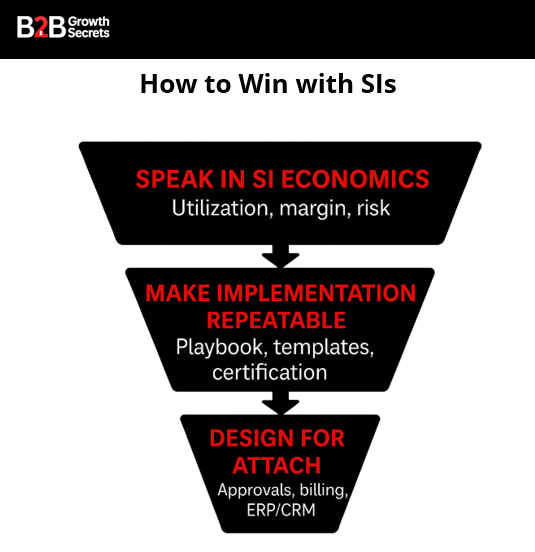Sell Through SIs, Align to CEPs, and Close Without Cutting Price
Welcome to B2B Growth Secrets, where every week, we listen to dozens of B2B Growth podcasts and extract the top actionable ideas. (For more context on these ideas, give the podcasts a listen)
In this issue:
Turn SIs into channel partners [Nathan Latka]
Align your story with key buyer moments [Exit Five]
Improve your close rates by addressing risk (don’t discount!) [John Barrows]
1. Turn SIs into channel partners
Software Founder Interviews (Nathan Latka), Episode: Genius Founder of Nue.io Gets OpenAI as Customer, Breaks $10,00,000 Sales (Sept 17, 2025)
If you want partners to sell you and earn a slot in their proposal templates, give them a fast, low-risk package to deliver, a simple way to make money, and clear attach paths.
Speak in SI economics: SIs care about utilization, margin, and risk. Package a 4-8 week “QuickStart” with a fixed scope, inputs, and outputs. Promise fast go-lives and fewer overruns – and back it with a published plan and 2-3 references. Point to your fastest go-live as proof.
Make implementation repeatable: Publish a partner playbook: sample SOW, RACI, data templates, reference architectures, and a sandbox tenants program. Certify roles (architect, consultant, admin) and list certified partners publicly so buyers can “pick a team” without calling you first.
Design for attach: Give SIs natural follow-on s approvals add-on shows how a single workflow can expand services scope without slowing TTV (time to value). (Business Wire)
2. Align your story with key buyer moments
The Exit Five CMO podcast (Dave Gerhardt), Episode: How To Turn Your Company Story Into Actionable Marketing Ideas with Pranav Piyush (Sept 25, 2025)
Many B2B teams craft a story, then stall. This episode is a playbook for moving from story to ), and use that as your weekly brief for ads, carousels, and short videos.
Make CEPs your creative brief. If an idea isn’t tied to a real entry point, it won’t show up when buyers are deciding.
How it works in practice
List Category Entry Points (CEPs). For example, think moments like “annual plan due,” “QBR next week,” “launching a new channel,” or “CFO asking for proof.” You want to be mentally available at those moments because CEPs are the building blocks of recall and growth. (LinkedIn Business Solutions)
Map each CEP to a Job To Be Done (JTBD). A job is the progress the buyer is trying to make (functional, emotional, social). Example JTBD focuses you on outcomes, not features. (Harvard Business Review)
Turn CEP+JTBD pairs into briefs. Each pair becomes a small re designing to show up when the cue happens and to help finish the job.
Here’s an example (for a marketing analytics SaaS compan
CEP: “Testing YouTube for the first time.”
JTBD: “Reduce risk while proving lift.”
Come up with:
Hook: “Launch YouTube without guessing.”
Proof: 60-second explainer on how MMM/incrementality avoids last-click traps.
Offer: test design checklist.
CTA: “Grab the test plan.”
Why this works: it pairs the trigger with a de-risked way to do the job.
3. Improve your close rates by addressing risk (don’t discount!)
The Advanced Selling podcast, Episode: Stop Discounting: Closing Strategies with John Barrows (Sept 23, 2025)
What kills late-stage deals is not price. It’s indecision and fear of making the wrong call. Reduce risk, guide the buyer, and never throw out a discount to “get it in this month.”
Want fewer no-decisions and stronger margins? Run these 5 steps on every late-stage deal:
Diagnose indecision (not just “status quo”). Use JOLT: Judge indecision (which means: diagnose how hesitant the buyer is and why, before you pitch more or push for a close), Offer a recommendation, Limit the exploration, Take risk off the table.
For example: “Based on your goals, pick Plan A. We’ll cap scope to 90 days, measure 3 KPIs, and exit if targets aren’t met.” This reduces fear and moves the buyer from anxious to assured. (sellingsherpa.com)
Proactive discounting destroys trust. Unasked-for discounts tell buyers your earlier price wasn’t real, inviting endless grinding now and at renewal. If they ask for a concession, trade it for commitment (longer term, more seats, faster start) instead of cutting price unprompted.
For example: “We can hold today’s rate for 24 months if we start with 50 seats and a 2-year term.” This protects price integrity and aligns economics to commitment.
Make procurement an early ally. Waiting to loop in procurement guarantees last-minute “nibbles” (small endgame asks like shortening term or hidden extras). Engage early, request their checklist, and pre-clear legal/security.
Here’s an example email: “We’re evaluating you for Q4. Could we review your preferred T&Cs and security artifacts now so signature isn’t a fire drill?” Early involvement cuts cycle time and reduces margin leakage. (GEP)
Run a no-surprise close. Price should never shock at proposal. Set an explicit “decision call” when the buyer tells you their date, and put a 10-minute “signing day” on the calendar. If they sign early, you convert it to onboarding.
For example: “You’ll decide by the 28th. Let’s book a 10-minute yes/no call then so we avoid chasing; I’ll also pencil a signing slot on the 29th.” This assumptive, buyer-friendly cadence maintains momentum without pressure. (monday.com)
t chase. End-of-month heroics and price pushes kill deals. Coach reps on red-zone
For example: a 45-second clip from the VP saying, “We’re ready on security, success plan attached, I’m your escalation path.” It reassures the buying group and keeps control with the rep.
Bottom line
Most “price problems” are fear problems. Lead with a clear recommendation, shrink perceived risk, and keep price integrity intact. (dreamdata.io)
Disclaimer
B2B Growth Secrets summarizes and comments on publicly available podcasts for educational and informational purposes only. It is not legal, financial, or investment advice; please consult qualified professionals before acting. We attribute brands and podcast titles only to identify the source; such nominative use is consistent with trademark fair-use principles. Limited quotations and references are used for commentary and news reporting under U.S. fair-use doctrine.


